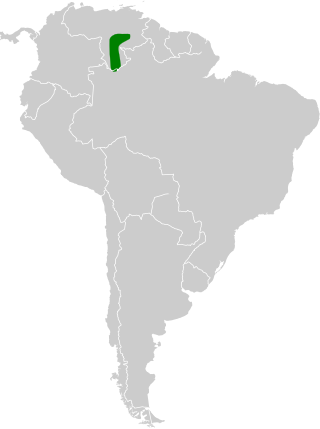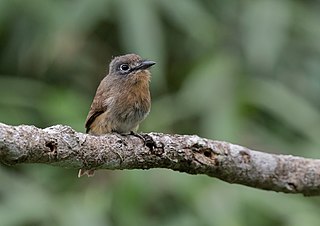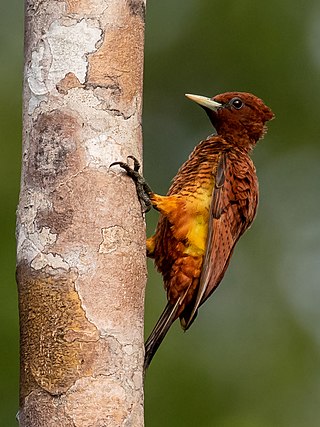
The russet-throated puffbird is a species of near-passerine bird in the family Bucconidae, the puffbirds, nunlets, and nunbirds. It is found in Colombia and Venezuela.

The Pantanal snipe is a bird in tribe Scolopancinai and subfamily Scolopacinae of family Scolopacidae, the sandpipers and relatives. It is found on Trinidad and Tobago and in every mainland South American country

The violet-chested hummingbird is a species of hummingbird in the "mountain gems", tribe Lampornithini in subfamily Trochilinae. It is found in Colombia and Venezuela.

The buff-breasted sabrewing, or sometimes Duida sabrewing, is a species of hummingbird in the "emeralds", tribe Trochilini of subfamily Trochilinae. It is found in Brazil and Venezuela.

The scissor-tailed hummingbird is an Endangered species of hummingbird in the "mountain gems", tribe Lampornithini in subfamily Trochilinae. It is endemic to Venezuela.

The black-fronted wood quail is a bird species in the family Odontophoridae, the New World quail. It is found in Colombia and Venezuela.

The Tacarcuna wood quail is a species of bird in the family Odontophoridae, the New World quail. It is found in Colombia and Panama.

The rufous-fronted wood quail is a species of bird in the family Odontophoridae, the New World quail. It is found in Colombia and Ecuador.

The rusty-breasted nunlet is a species of near-passerine bird in the family Bucconidae, the puffbirds, nunlets, and nunbirds. It is found in Argentina, Brazil, Colombia, Ecuador, Guyana, Paraguay, Peru, Suriname, Venezuela, and possibly French Guiana.

The rufous-banded owl is a species of owl in the family Strigidae. It is found in Bolivia, Colombia, Ecuador, Peru, and Venezuela.

The Maranon pigeon, Peruvian pigeon or Salvin's pigeon is a species of bird in the family Columbidae. It is found in Ecuador and Peru.

The grey-breasted wood wren is a species of bird in the family Troglodytidae. It is found from Mexico to Bolivia.

The red-billed woodcreeper is a species of bird in the subfamily Dendrocolaptinae of the ovenbird family Furnariidae. It is found in Brazil, French Guiana, Guyana, Suriname, and Venezuela.

The speckle-breasted wren is a species of bird in the family Troglodytidae. It is found in Colombia, Ecuador, and Peru.

The scaly-breasted woodpecker, also known as the scale-breasted woodpecker, is a subspecies complex of bird in subfamily Picinae of the woodpecker family Picidae. It is found in Bolivia, Brazil, Colombia, Ecuador, Peru, and Venezuela.

The gartered trogon, also known as the northern violaceous trogon, is a bird in the family Trogonidae, the quetzals and trogons. It is found in Mexico, all of Central America, and Colombia, Ecuador, Peru, and Venezuela.

The Amazonian trogon, is a species of bird in the family Trogonidae, the trogons and quetzals. It is found in Bolivia, Brazil, Colombia, Ecuador, Peru, and Venezuela.

The foothill screech owl is a species of owl in the family Strigidae. It is found in Bolivia, Brazil, Colombia, Ecuador, Guyana, Suriname, and Venezuela.

The citron-throated toucan is a near-passerine bird in the family Ramphastidae, the toucans, toucanets, and aracaris. It is found in Colombia and Venezuela.

The butterfly coquette is a species of hummingbird in the "coquettes", tribe Lesbiini of subfamily Lesbiinae. It is found in Bolivia, Brazil, Colombia, Ecuador, Peru, and Venezuela.























